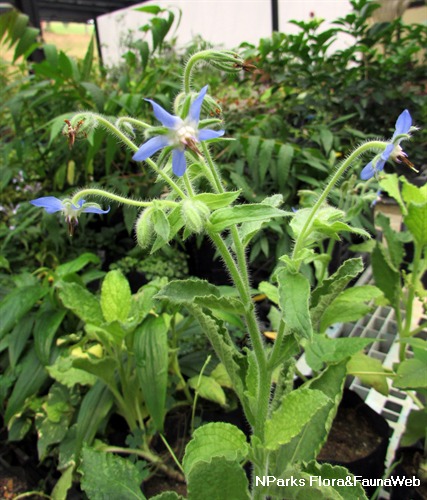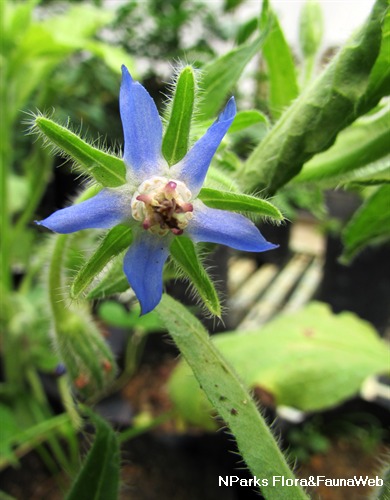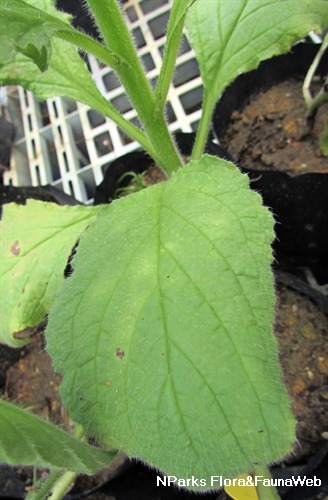
Name
Classifications and Characteristics
| Plant Division | Angiosperms (Flowering Seed Plants) (Dicotyledon) |
|---|---|
| Plant Growth Form | Herbaceous Plant |
| Lifespan (in Singapore) | Annual |
| Maximum Height | 0.3 m to 0.9 m |
Biogeography
| Native Distribution | Europe |
|---|---|
| Native Habitat | Terrestrial |
| Preferred Climate Zone | Sub-Tropical / Monsoonal, Temperate |
Description and Ethnobotany
| Growth Form | Herbaceous plant up to 0.9 m tall. |
|---|---|
| Foliage | The alternate leaves are hairy and oval with wavy leaf margins. |
| Stems | The branched stem is coarse with white hairs. |
| Flowers | Flowers are borne in reddish stems. Each flower has five pinkish-red sepals and five blue petals. The sepals are star-shaped and covered with white hairs. |
| Ethnobotanical Uses | Edible Plant Parts : Edible Leaves, Edible Flowers, Edible Seeds Food (Fruit or Vegetable): Leaves can be consumed raw as salads or cooked. They are also used to make drinks. Flowers are also edible, but more often, they are used as decorative garnish on dishes or drinks. |
Landscaping Features
| Desirable Plant Features | Ornamental Flowers |
|---|---|
| Landscape Uses | Parks & Gardens, Small Gardens, Flowerbed / Border, Container Planting |
Fauna, Pollination and Dispersal
| Pollination Method(s) | Biotic (Fauna) (Insects (Bee)) |
|---|
Plant Care and Propagation
| Light Preference | Full Sun, Semi-Shade |
|---|---|
| Water Preference | Moderate Water |
| Plant Growth Rate | Fast |
| Rootzone Tolerance | Well-Drained Soils |
| Propagation Method | Seed |
Foliar
| Mature Foliage Colour(s) | Green |
|---|---|
| Mature Foliage Texture(s) | Hairy / Hirsute |
Floral (Angiosperm)
| Flower Colour(s) | Blue |
|---|
Fruit, Seed and Spore
| Mature Seed Colour(s) | Brown |
|---|
Image Repository
Others
| Master ID | 32599 |
|---|---|
| Species ID | 7011 |
| Flora Disclaimer | The information in this website has been compiled from reliable sources, such as reference works on medicinal plants. It is not a substitute for medical advice or treatment and NParks does not purport to provide any medical advice. Readers should always consult his/her physician before using or consuming a plant for medicinal purposes. |



